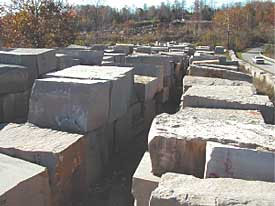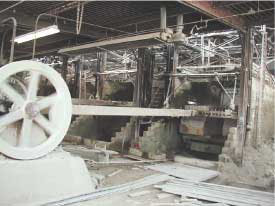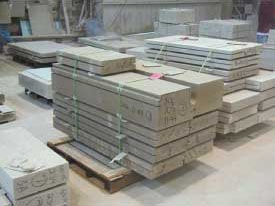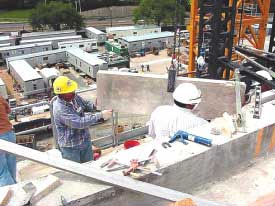The Stone: Material Command Center
By Tom Inglesby
 With the quarries shut down for winter, The Phoenix Project was lucky to find suitable stone already harvested. |
It still is.
Fifty miles south of Indianapolis and 637 miles from Washington, the small town of Ellettsville (pop. 5,068) stands in one of the most cultivated limestone areas in the country. Founded in 1837, the town has long been a source for the carving, cutting and shaping of this indigenous building material.
Indiana limestone is recognized as one of the better grades available for fa?ade work and is used in many, perhaps a majority of government buildings at all levels ? federal, state, county and community ? plus a wide range of monuments, cathedrals and other buildings. Capitalizing on this resource, Ellettsville proudly proclaims its motto, "The Builders of American History."
Situated in Ellettsville is Bybee Stone, a company that can trace its history back to the earliest days of the town. In fact, the original company was Matthews Brothers, started about 1846 with a small quarry that grew into one of the region's better-known suppliers. Besides quarrying the limestone, Matthews Brothers fabricated it into the usable building material that was growing in demand across the country. The Bybee family bought the company in 1978, and today William Bybee runs the family business as CEO.
As Bybee notes, "We're fabricators of Indiana limestone quarried in the area. We work on new buildings, restorations of old buildings, and additions to existing buildings. We did the last 10 years of work on the Washington Cathedral, a job that was started in 1906 and didn't finish until 1989."
In 2001, Bybee added The Phoenix Project, the rebuilding of the Pentagon, to its portfolio.
Because the Pentagon had been designated as a National Historical Landmark on October 5, 1992, and this designation automatically placed it in the National Register of Historic Places, any work done on the building is governed by some of the strictest requirements for authenticity possible. When the original building plans were found and reviewed, it was noted that the cladding on "E" Ring, the visible exterior of the building, was made up of Indiana limestone.
The masonry contractor, Masonry Arts, knew Bybee's experience with government building renovation. Once the demolition of the impacted area was done the two came together quickly on the particulars. "We had a lot of dealings with the folks who were already on the site when the attacks happened," Bybee says. "The government decided to use the people on site so there wouldn't have to be any mobilization. Because this is an area we specialize in, we were able to get up and running on the project quickly."
 An old style steel gang saw cuts the limestone for the Pentagon fa?ade at Bybee Stone. |
"We have a lot of new equipment that will do the same thing as the old equipment," explains Bybee. "You just have to use steel as opposed to diamond blades in the gang saws. The problem was to duplicate what they did back in the 1940's. Then again, some of our equipment probably goes back to that time."
Bybee was already working with the PenRen project on the remodeling of the Pentagon. As Bybee says, "We were working on the Metro entrance, making drawings, and had already been given a contract for material to be used on the opposite side from where the plane went in. Six weeks after September 11, Roy Swindel of Masonry Arts called me and asked if I was willing and able to do the project and I told him yes. Everything happened so fast after that, I don't think I ever did get a contract to sign."
He continues, "We let the architects look at a wide range of stone that was available and they picked what they wanted to use. The quarry season was over, it being close to winter here, and so availability was based on finding quarries that had stock. They looked at color and consistency of the stone, but they had to pick from the quarries that had the stone available. Independent Limestone Company supplied the entire supply of block."
Bybee admits the pressure of time ? and the emotional aspects of the project ? caused some stress. Another issue was the age of the building, 60 years. A lot of discoloration and staining was evident on all the exterior walls of the Pentagon and, as he says, "The 'new factor' will be there for some number of years, until environmental actions make everything the color of the older stone."
He adds, "From what I've heard from some of the old timers that are still around, when they built the building, they gave all the contractors, fabricators and quarries next to no time to be ready. Every quarry in the belt contributed block; no block was turned down."
When you talk about that many cubic feet, that's probably everything that was available, even during the heyday of Indiana limestone. "There were 30 to 50 fabricators and probably that many quarries," Bybee recalls. "Now we don't have anything close to that. Even so, they were really stressed to get that much block out, fabricate it, and get it on site.
 Bybee Stone fabricated the pieces to dimensions on original 1941 drawings. |
"We made three trips and sent draftsmen to the site. Masonry Arts, the general contractor, and the architect supplied us with information. Of course, they wanted us to move quickly and be done in March or April, so we couldn't spend much time collecting information. I think everybody jumped through a lot of hoops to get the job done properly and to give us time to fabricate it and have it ready for them when they needed it."
In an article in the Washington Post, Bybee Stone employees are quoted about the emotional impact of working on a project of such significance. In the article, Christina Pino-Marina wrote about Jeremy Epeards, a 23-year old planer operator whose father and grandfather once worked in the same stone plant. "You really put your heart and soul into it. I mean, that stone is going to the Pentagon. It's something to really be proud of."
"I think that all the people that work here were emotionally involved," Bybee says quietly. "This is different than our normal job. Not from the technical standpoint, but for why we were doing it. Everybody gave it a little extra all the way through. Most of the people that work here were affected in some way by knowing that so many people were killed on September 11th. Being able to put a building back that was part of that horrible situation is a very positive thing. They were doing something very positive with their minds and hands. Probably a lot of people would like to do that if they had the chance."
The first truckload was ready the first week of December, and Bybee was done with everything by mid-April. There were 45 truckloads of stone in all. The first of the new stones was placed on February 25, 2002; the last regular stone was set on June 7. On June 11, a memorial capstone was inserted near ground level, covering a time capsule. This was one of the smoke-stained limestone blocks from the impact area, with the date of the attack carved in it.
 Stonemasons set one of the Bybee limestone units near the top of the Pentagon as the project nears completion. |
In the end, 14,273 cubic feet of Indiana limestone ? about 2.1 million pounds ? came through Bybee Stone and left in the form of slabs, lintels, cornice and other shapes. Among them was one very special stone. Will Bybee explains, "It's a tradition, especially for high profile projects, like the Washington Cathedral, that a stonecutter will put his name on it when he finishes. We have all our guys put their name or initials on every piece of stone so if we have a problem on the site we know who cut the piece. In this case, the idea was to use one of President Bush's quotes and let each of the stonecutters and some of the stone planers cut one letter into it. Then we let everybody in the plant sign the back of it."
Originally, that piece was going to end up in the building fa?ade. That's all changed. The stone that the Bybee crew carved was stored at the worksite and, even though protected from vandalism by a fence, attracted attention. Soon other workers wanted to add their names and the stone took on a whole new meaning to those on The Phoenix Project. The stone was installed in the Pentagon's first floor escalator lobby, Wedge 1 near corridor 4 where the plane hit.
With somewhat typical Midwestern modesty, Bybee says, "We really didn't send it over there to do anything but go into the building. We still have a lot of work to do on the Pentagon [the Metro entrance contract], and that's our concern now."
He then sums up the thoughts of his workers and himself. "I'd be pretty callous not to be affected by working on this project. In our company, we do this work all the time ? it just becomes second nature and we don't think too much about the building it will go on. We work on a lot of buildings that have some historical significance but in this case, we're very lucky to be in a position that we could do this job, and we've tried to do good work that's going to be around for a long time. Basically, it was just an honor to be able to put that building back into shape."
As Rick Rentschler, a stonecutter at Bybee Stone told Peno-Marina of the Post, "It's not the fanciest building, but it's a nice building, and it's an honor. Those other jobs, they were jobs. This is personal."
About the Author
Tom Inglesby is a San Diego-based freelance writer whose work has appeared in numerous online and print publications. He is the winner of the Construction Writers Association's 2002 Boger Award for Special Reports.


















